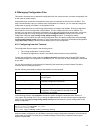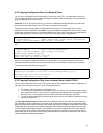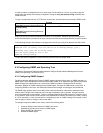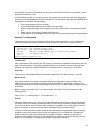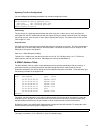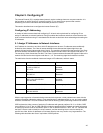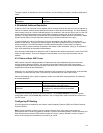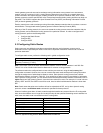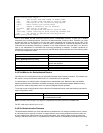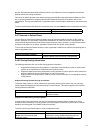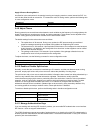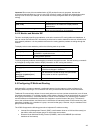
42
To assign multiple IP addresses to network interfaces, use the following command in interface configuration
mode:
Command Purpose
ip address
address I mask
secondary
Assign multiple IP addresses to network
interfaces.
5.2 Establish Address Resolution
A device in the IP can have both a local address (which uniquely identifies the device on its local segment or
LAN) and a network address (which identifies the network to which the device belongs). The local address is
more properly known as a data link address because it is contained in the data link layer (Layer 2 of the OSI
model) part of the packet header and is read by data link devices (bridges and all device interfaces, for
example). The more technically inclined will refer to local addresses as MAC addresses, because the Media
Access Control (MAC) sub-layer within the data link layer processes addresses for the layer.
To communicate with a device on Ethernet, you first must determine the 48-bit MAC or local data link
address of that device. The process of determining the local data link address from an IP address is called
address resolution. The IC35516 software uses the Address Resolution Protocol (ARP) for address
resolution. ARP is used to associate IP addresses with media or MAC addresses. Taking an IP address as
input, ARP determines the associated media address.
Once a media or MAC address is determined, the IP address/media address association is stored in an ARP
cache for rapid retrieval. Then the IP datagram is encapsulated in a link-layer frame and sent over the
network.
5.2.1 Define a Static ARP Cache
ARP provides a dynamic mapping between IP addresses and media addresses. Because most hosts
support dynamic address resolution, you generally do not need to specify static ARP cache entries.
Completing this task installs a permanent entry in the ARP cache. The entry is used to translate 32-bit IP
addresses into 48-bit hardware addresses.
Optionally, you can specify that the software respond to ARP requests as if it was the owner of the specified
IP address. You also have the option of specifying an interface when you define ARP entries.
Perform the following task in global configuration mode, to provide static mapping between IP addresses
and media addresses.
Command Purpose
arp ip-address hardware-address
Globally associate an IP address with a media
(hardware) address in the ARP cache.
arp ip-address hardware-address
[interface ]
Specify that the software respond to ARP
requests as if it was the owner of the specified
interface.
To display the ARP being used on a particular interface, use the show interface in top mode or global
configuration mode. Use the show arp command in top or configuration mode to examine the contents of
the ARP cache.
Configuring IP Routing
IP routing protocols are divided into two classes: Interior Gateway Protocols (IGPs) and Exterior Gateway
Protocols (EGPs).
Note: The word gateway is often a part of a routing protocol’s name, since many routing protocol
specifications refer to routers as gateways. However, a protocol translation gateway is usually defined by the
Open System Interconnection (OSI) reference model as a Layer 7 device, whereas a router is a Layer 3
device, and routing protocol activities occur at the Layer 3 level.



